Hurricanes and storms play a constant threat to off-shore drilling and the crews. Yearly there are around 100 severe weather disturbances from May to November. While 10 of these 100 storms develop into tropical storms, five may become hurricanes, and likely only 2-3 are going to make it to landfall in the United States.
It is essential to be aware of the hurricane seasons and in which parts of the United States may face impact. The Atlantic hurricane season runs from June 1st to November 30th, while the Eastern Pacific hurricane season runs from May 15th to November 30th.
The weather each year has a tremendous effect on off-shore drilling and the production effort of the crew. Being aware of weather consequences can help you and your team respond proactively to incoming weather threats.
The Effects of Weather
You can expect a fall in production when a hurricane hits the infrastructure. The production of oil and natural gas will continue at a steady decline. After the storm passes, all of the facilities will be inspected and repaired to resume production.
The success of start-up operations will depend on the level of damage sustained. The production profile of the rig is recorded during hurricane season (June 1-November 30) and during the off-season (December 1-May 31). Production during hurricane season is slightly less than during the off-season.
You can use the off-season to gain back lost production from the hurricane season. Depending on the season, the variable can be quite small, which is good news.
Weather events can impact off-shore production for a few days or longer. A damaged infrastructure will affect production for weeks. In the case of an extreme weather event, production may drop or cease for as long as months or even years.
Being Prepared
The best way to prevent any losses in off-shore drilling is always ensuring that a plan is in place for the worst-case scenario. Your crew must be aware that evacuation may occur at any time, as the weather can be unpredictable.
Dependant on the size, anywhere from 25-200 people work on an off-shore rig. You’ll need an evacuation plan prepared for all of the crew members that are working on the platform. The key to being ready in the event of an extreme weather event is yearly, on-going planning and practice.
Be sure to delegate a team dedicated to hurricane and storm planning operations. Once you’ve defined a list of all essential and non-essential personnel, you will first evacuate the people who fall under the “non-essential personnel” category. Then you will evacuate any of your “essential” staff who do not stay behind to keep the rig running.
When the weather is not too severe, about a quarter of the crew can be left behind to “batten down the hatches” and ride out the storm. This way, production can remain constant, if slightly decreased. Prepare food and other supplies for any of the mission-critical crew who must remain on the platform.
In the days before worsening conditions, prepare to have helicopters ready for the evacuation. Only so many people can ride in one helicopter, so it is essential to coordinate flight schedules and have a plan in place.
Create your evacuation flight plans a few days in advance of oncoming storms, because strong winds, thunder, and lightning can cause helicopter difficulties when landing.
Once evacuated from the site, you’ll need to have prepared shelter for the crew to take refuge. If conditions are too risky to stay close by a docking site, you can send them out to hotels in the local area to evacuate.
Have the crew leave the rig with just the basics–a change of clothes, wallet, and phone can help the evacuated crew wait out the storm in comfort. Limited the amount of crew baggage will help expedite the process.
Prevent Production Loss
In the event of an evacuation, it is crucial to shut off the rigs to prevent any spills and product loss. There are two different ways to shut off the wells.
Cutting off the oil and gas wells is easier said than done. An off-shore oil field is often comprised of several wells. There is a chemical injection inserted into each well to stabilize the internal temperature and pressure of the rig.
Once the well has stabilized, it is safe to shut down. This shut-down is called a “soft” shut-in. A soft shut-in allows work to resume in a few days once the storm passes.
A more permanent or “hard” shut-in could require more drilling to get the oil flowing again. When a projected storm path takes several days to run its course, a hard shut-in is needed.
Before the storm hits, a crew member should strap down any equipment affected by the wind.
Technology Shift
There have been many technological advancements to aid in the process of off-shore drilling. Improvements in equipment, training techniques, and materials have helped refine the process.
In the past, off-shore drilling platforms were often anchored in place. Today’s oil companies employ drillships and platforms that can pivot and move out of harm’s way. Anchored platforms give the crew a better chance of weathering out a storm on-rig.
Polymers are now used in off-shore drilling and act as an excellent insulation solution for the pipelines. Marine oil operations typically require these polymers.
Polymers help form a protective barrier between the seawater and oil lines. They are thus preventing clogs and potential ruptures from backed-up pipes.
Another technological advancement is the creation of submersible helicopter models. These choppers allow the crew to train for emergencies, like a helicopter accident.
Global weather patterns change continually. Hurricanes and storms are the largest threat to off-shore drilling. The primary way to prevent any losses is by creating a plan in the event of storm conditions. Being able to evacuate and get back on board quickly will significantly increase production and minimize production downtime.








